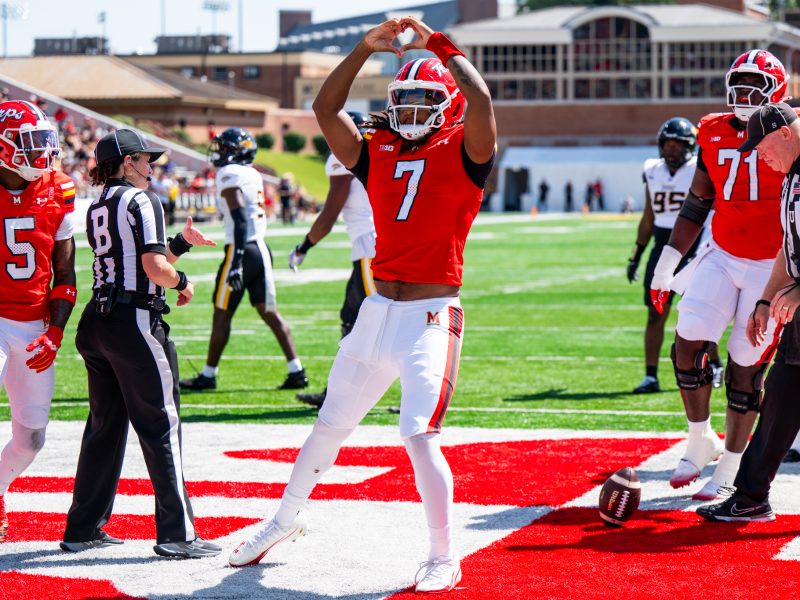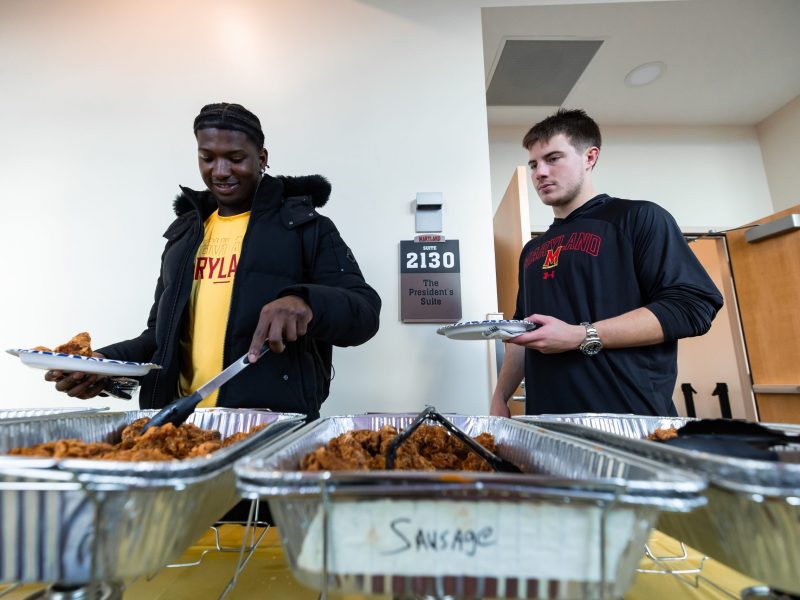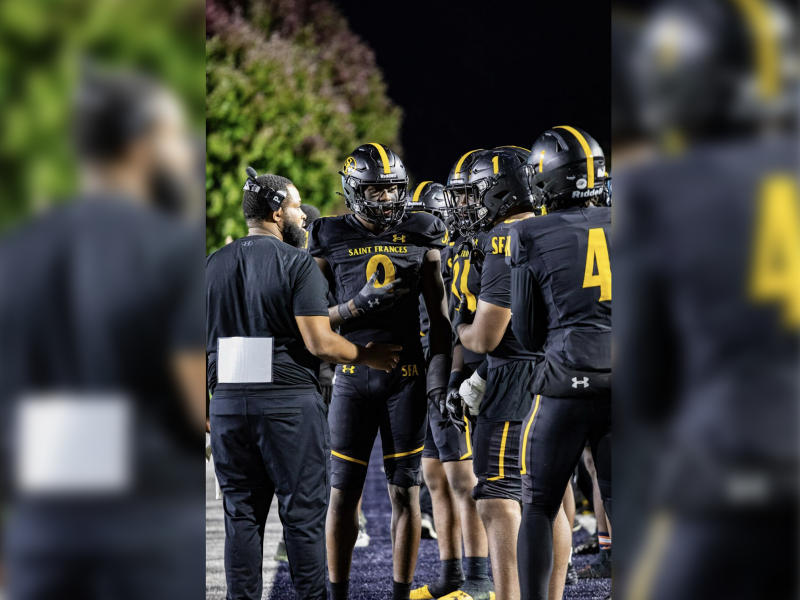Back when Maryland football’s season showed promise and the hype train quickly gained passengers, coach Mike Locksley pumped the brakes.
In the second game of his tenure as the full-time coach, Locksley’s squad had throttled then-No. 21 Syracuse. The week before, the Terps had demolished Howard. A combined score of 142-20 over two weeks drew eyes from around the country, and the oft-hibernating fan base in College Park began to stir.
But there Locksley was, at the lectern inside the Gossett Football Team House, reminding listeners — and especially those players outside the room, jubilant over a 2-0 start — not to get ahead of themselves.
“There’s all types of things we need to continue to work to improve,” Locksley said Sept. 7 after the 63-20 win over the Orange. “It is hard to get them to understand that every day you have to come to work with the right mindset and maximize it every single day. That’s been the toughest challenge for us. But guess what? We drew the line in the sand and we ain’t backing off of it as a staff. We’re going to get it out of them.”
[Read more: Maryland football ends season with seventh straight loss, a 19-16 defeat to Michigan State]
They never did.
For as high as the Terps flew in their first two weeks, the season crashed down around them, with a brief respite against Rutgers the lone win in their final 10 matchups. The offseason has now begun, the shedding of players is in full force and Locksley appears to have his work cut out for him to turn the program around.
But as Locksley so often echoed during the season-ending spiral, his first year in charge was about laying the groundwork for the future. To find any sort of success on Saturdays, the team needs to develop the right “habits and behaviors” — one of Locksley’s favorite coach-isms. It’s that ideal that may be one of the largest focuses this offseason as the coach attempts to rebound from a 3-9 campaign.
“All parts of the organization will be evaluated at the end of the year,” Locksley said Nov. 26. “We will make the right decisions that we need to make to keep us moving in the right direction.”
Shortly after Maryland’s season-ending 19-16 loss to Michigan State over Thanksgiving weekend, that process began. Locksley had a full slate of meetings that Sunday and Monday, analyzing what players did well and what aspects of the team needed improvement. They discussed players’ futures with the team, and some — including wideout Carlos Carriere and linemen Breyon Gaddy and Brandon Gaddy — opted to leave the program.
Running backs Anthony McFarland and Javon Leake, meanwhile, announced they’d forgo their remaining eligibility to enter the NFL Draft. The pair had accounted for two-thirds of the Terps rushing yards this year and over one-third of the total offensive production. Their departure leaves a massive hole in Locksley’s scheme.
For a team so often characterized as explosive, the more accurate descriptor of its offense was boom-or-bust. Those first two weeks, though, everything went right.
Quarterback Josh Jackson, who transferred during the offseason from Virginia Tech and won the starting job, threw for 541 yards and seven touchdowns. Maryland’s running back depth appeared to be otherworldly: McFarland rushed for four scores, Leake broke out for 107 yards and two touchdowns against Syracuse and Lorenzo Harrison, Jake Funk and Tayon Fleet-Davis all chipped in impressive stat lines.
“We were very confident in ourselves,” Jackson said after beating the Orange. “The style of play is hard to match. Our tempo and the way we execute, that’s how we go out and expect it. None of us thought this was a surprise for us to be able to put up points. I’m just glad we were able to go out and do it.”
[Read more: For Mike Locksley, building Maryland football back up is a “marathon and not a sprint”]
Jackson’s run-pass-option reads were crisp, big plays popped with regularity and the Terps were ranked for the first time since 2013. So, what allowed for this kind of production?
“Our execution,” Locksley said Sept. 7. “I know that sounds like coach speak, but we run a style of offense that the defense can’t be right unless they out-execute us.”
Soon, that wouldn’t be the case. Big plays grew scarce — or hardly mattered in the grand scheme of a blowout. Miscues — be it penalties or turnovers — became rampant. The explosive offense of the first two weeks became a dud.
Just as the sleeping bear that is the football fan base in College Park began to perk up, the Terps traveled to Temple.
“We want to give [the Owls] all the credit,” Locksley said. “They out-executed us.”
Then came Penn State, a Friday night matchup with a record number of student ticket requests. Maryland added overflow student seating and canceled classes at midday to prepare. Even after a 20-17 loss to Temple — which included two turnover-on-downs late in the fourth quarter inside the Owls’ red zone — the students turned out.
“Obviously,” Locksley began, “Disappointed. Disappointed in our effort, disappointed in the discipline we played with tonight. We were out-coached, we were out-played.”
The Nittany Lions came down to College Park and torched the Terps, 59-0. Quarterback Sean Clifford nearly reached 400 yards passing and six players found the end zone at least once. The fans left in force by the time Penn State had a 38-point halftime lead, and they never came back.
That was the chance to recapture a lively atmosphere; instead, what turned into just one of five 30-point losses took the life out of a once-lively season.
Maryland rebounded against a hapless Rutgers squad, but went on to lose its final seven contests. Backup quarterback Jack Plummer led Purdue to a 40-14 victory, further poking holes in the Terps’ secondary. He completed 33 of his 41 attempts for 420 yards and three touchdowns.
Plummer was the second gunslinger to earn Big Ten Offensive Player of the Week honors after playing Maryland, following Clifford’s lead, exploiting the conference’s worst defense — defensive coordinator Jon Hoke’s unit allowed 449.2 yards per game.
That would be the first of Tyrrell Pigrome’s three consecutive starts, as Jackson recovered from a high-ankle sprain. Injuries began to thin out the running back unit, too, with Harrison and Funk ruled out for the year with knee injuries, while McFarland was hampered with an ankle injury for much of the campaign. Fleet-Davis missed the final two games after he was charged with seven traffic-related violations.
The spate of injuries left Leake as Maryland’s best weapon for much of the year.
“We don’t have that much depth,” Leake said Nov. 26. “You’ve just got to be tough. You really have no choice but to do it.”
Leake finished third in the Big Ten with 1,595 all-purpose yards, proving his explosiveness as a kick returner and as a ball-carrier. Still, the losses kept coming. Ranked matchups with Minnesota, Michigan and Ohio State resulted in losses with a combined 163-31 scoreline.
On Senior Day, a struggling Nebraska team came to College Park and ran away with a 54-7 victory, a late 58-yard touchdown from Leake the lone bright spot.
“We need to come together more,” left tackle Jaelyn Duncan said Nov. 26. “And when times are rough, just stick together, work it out, things will get better.”
Throughout the season, as one-sided defeats stacked up, Locksley often spoke on the need to ignore the scoreboard. He often brought up how in his first year, the focus was to enact the standard for his program to live by. He wanted to get across his expectations for how to practice and how to play.
They all fall under the umbrella term of “habits and behaviors.”
“If you know you should be in class, you need to be in class,” tight end Chigoziem Okonkwo said Nov. 26. “If you have a lift at this time, you need to be at that lift at that time. When guys miss things like that, it shows up on the field. That same discipline that you don’t have off the field shows up when you get on the field, and you can see it, honestly.”
Players say there have been strides, but the product during a 3-9 season suggests development is still needed. And after losing Leake and McFarland to the draft and numerous other players to the transfer portal, Locksley faces a critical offseason of recruiting to refill his squad and training to improve the results.
But Locksley has maintained that creating a groundwork for future seasons was the primary task at hand in 2019. And there’s only one way to find out what that foundation may one day hold.
“We got some really good players that have made decisions to come play here,” Locksley said Nov. 26. “We’ll build on it.”






